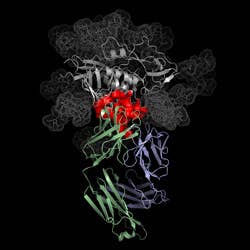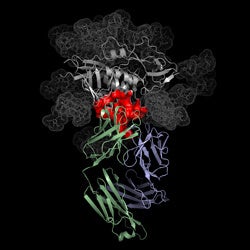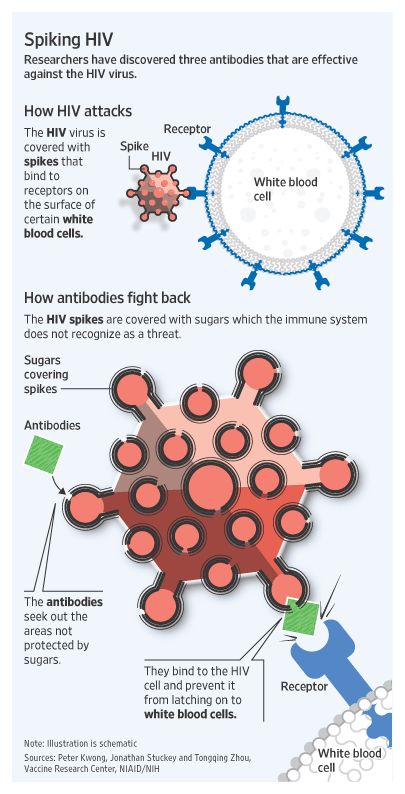Antibody Neutralizes 91% of HIV Strains, Strong Step Towards a Vaccine

Share
Will HIV eventually go the way of smallpox and polio? Earlier this month, scientists at the National Institute of Health (NIH) announced their discovery of three new HIV antibodies, the most powerful of which neutralizes 91% of all HIV strains. These are the strongest antibodies yet found, and they could hold the key to developing a vaccine to AIDS.
HIV antibodies themselves aren’t rare, and scientists regularly find ones that are effective against a few different strains. But until last year, the most powerful antibody found only protected against about 40% of strains. New techniques for rapidly identifying antibodies have changed this, and sparked an unprecedented number of breakthroughs: in the past year, about half a dozen broadly neutralizing antibodies have been identified. These new antibodies are extremely potent (they neutralize the virus at low blood concentrations) and protect against many more strains of HIV. The research was published as two separate papers in Science (found here and here).
The new antibodies were found in the blood of an HIV-positive man dubbed Donor 45 in the scientific literature. Donor 45 is what's called a long-term nonprogressor. He has been living in good health with HIV for over 20 years, and although his body has standard viral load, his antibodies keep the virus from invading his cells. His body generates the antibodies naturally, and they started being produced after the virus was already contracted. Scientists do not believe Donor 45’s antibodies are the result of any special genes, and they’re hoping that anyone’s body could be induced into producing them.
As of 2008, the United Nations estimated that approximately 33 million people had HIV/AIDS, and between two and three million people contract the virus each year. An HIV vaccine has been the holy grail of AIDS research, but until recently the results have disappointed. The AIDSVAX vaccine developed by VaxGen failed its North American trial in 2003, and a second trial in Thailand only reduced the rate of transmission by 26%. But previous attempts weren’t working with the antibodies we have today, and there are good reasons to think that the next vaccine will be a game changer.
Like most viruses, HIV is capable of mutating and adapting to the immune systems of its hosts, which accounts for the variety of virus strains and complicates efforts to develop a comprehensive vaccine. But one section of the virus does not mutate: the viral “spike” which punctures cell walls and delivers the invading genetic cargo. Because a mutation on the spike would prevent the virus from replicating itself, essentially all existing strains of HIV are identical along this site. The most effective antibodies – like those discovered over the last year – are ones that neutralize this Achilles’ heel common to all strains of the virus.
Scientists used this critical site to generate a “resurfaced protein probe” – basically a reconstructed version of the virus that mimics the structure of the spike and attracts relevant antibodies in the blood. This provides a method to quickly test for AIDS-specific antibodies in individuals with HIV, and is the most promising technique for developing any type of universal vaccine. As we’ve previously reported, efforts are currently underway to develop a universal influenza vaccine using the same basic approach.
Be Part of the Future
Sign up to receive top stories about groundbreaking technologies and visionary thinkers from SingularityHub.


The new antibodies cover most HIV strains, but not all. Researchers are now working on combining multiple antibodies into a cocktail capable of neutralizing all variants of the virus. Unpublished research by Dr. John Mascola, deputy director of the Vaccine Research Center and coauthor on the study, shows that combining multiple broadly neutralizing antibodies results in a near-universal vaccine – only 1 strain in 95 survived an early combo.
The next step – developing a vaccine from the antibodies – is no simple task, as researchers are publicly recognizing. Generating a vaccine requires making a harmless version of the virus in question, one which can be safely introduced to the immune system. HIV is particularly tricky to replicate safely because its dead form loses its antigenicity - its capacity to generate an immune antibody response, which is the point of a vaccine. The antibodies found in Donor 45 will only lead to a vaccine if they can be used to generate an innocuous, antigenic form of the virus.
But there's good news: the proof of concept has already arrived. As the Wall Street Journal has reported, research at Merck & Co. earlier this year showed that reverse engineering an HIV vaccine from antibodies is possible. The study used much weaker antibodies than those recently discovered (i.e. they were not broadly neutralizing). The process was delicate and required some creative chemistry, adding additional bonds to the viral structure to maintain its shape in a harmless form - but it worked. Recreating this success with broadly neutralizing antibodies holds a great deal of promise for a future universal HIV vaccine.
Vaccination wiped out both polio and the smallpox virus, which were the devastating diseases of their day. Now, both HIV and (as we recently reported) cancer are being targeted using modern techniques, and could soon join the list of vaccination success stories. A great deal of work lies ahead, but the initial results – and the rapid pace with which they’re pouring in – should be a source of hope for the future.
[image credit: National Institute of Allergy and Infectious Disease VRC, The Wall Street Journal]
Drew Halley is a graduate student researcher in Anthropology and is part of the Social Science Matrix at UC Berkeley. He is a PhD candidate in biological anthropology at UC Berkeley studying the evolution of primate brain development. His undergraduate research looked at the genetics of neurotransmission, human sexuality, and flotation tank sensory deprivation at Penn State University. He also enjoys brewing beer, photography, public science education, and dungeness crab. Drew was recommended for the Science Envoy program by UC Berkeley anthropologist/neuroscientist Terrence Deacon.
Related Articles

Single Injection Transforms the Immune System Into a Cancer-Killing Machine

This Light-Powered AI Chip Is 100x Faster Than a Top Nvidia GPU

This Week’s Awesome Tech Stories From Around the Web (Through December 20)
What we’re reading

